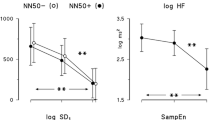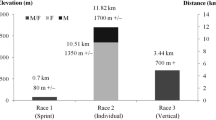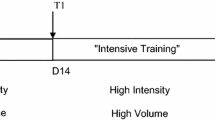Abstract
To evaluate if changes in athletes’ physical fitness due to seasonal training are associated with changes in cardiovascular autonomic control, nine swimmers (three males and six females; aged 14–18 years) were evaluated before and after 5 months of training and competitions. Maximal oxygen consumption \((\dot {V} \hbox{O}_{2\max})\) and ventilatory threshold were determined during a maximal test; heart rate (HR) and blood pressure (BP) variabilities’ power spectra were calculated at rest (supine and sitting positions) and in the recovery of two exercises at 25 and 80% pre-training \(\dot {V} \hbox{O}_{2\max}.\) At the end of the season: (a) \(\dot {V} \hbox{O}_{2\max}\) and ventilatory threshold increased respectively by 12 and 34% (P<0.05); (b) at rest, HR decreased by 9 b min−1 in both body positions, whereas BP decreased in supine position only by 17%. No change in low frequency (LF, 0.04–0.15 Hz) and high frequency (HF, 0.15–1.5 Hz) normalized powers and in LF/HF ratio of HR variability and in LF power of systolic BP variability was observed. In contrast, a significant increase in HF α-index (about 12 ms mmHg−1) was found; (c) during recovery no change in any parameter was observed. Seasonal training improved exercise capacity and decreased resting cardiovascular parameters, but did not modify vagal and sympathetic spectral markers. The increase in α-index observed at rest after the season and expression of augmented baroreflex sensibility indicated however that HR vagal control could have been enhanced by seasonal training. These findings suggested that autonomic system might have played a role in short-term adaptation to training.


Similar content being viewed by others
References
Aubert AE, Seps B, Beckers F (2003) Heart rate variability in athletes. Sports Med 33:889–919
Barney JA, Thomas JE, Groban L, Farrell PA, Hughes CV, Smith JJ (1988) Carotid baroreflex responsiveness in high-fit and sedentary young men. J Appl Physiol 65:2190–2194
Camm AJ, Malik M, Bigger JT, Brethard G, Cerutti S, Cohen RJ, Coumel P, Fallen EL, Kennedy HL, Kleiger RE, Lombardi F, Malliani A, Moss AJ, Rottman JN, Schimdt G, Schwartz PJ, Singer D (1996) Heart rate variability. Standards of measurements, physiological interpretation and clinical use. Circulation 93:1043–1065
Carter JB, Banister EW, Blaber AP (2003) Effect of endurance exercise on autonomic control of heart rate. Sports Med 33:33–46
Cooke WH, Reynolds BV, Yandl MG, Carter JR, Tahavnainen KUO, Kuusela TA (2002) Effects of exercise training on cardiovagal and sympathetic responses to Valsalva’s maneuver. Med Sci Sports Exerc 34:928–935
Dixon EM, Kamath MV, McCartney N, Fallen EL (1992) Neural regulation of heart rate variability in endurance athletes and sedentary controls. Cardiovasc Res 26:713–719
Fagard RH (2001) Exercise characteristics and the blood pressure response to dynamic physical training. Med Sci Sports Exerc 33(suppl 6):S484–S492
Garet M, Tournaire N, Roche F, Laurent R, Lacour JR, Barthelemy JC, Pichot V (2004) Individual interdependence between nocturnal ANS activity and performance in swimmers. Med Sci Sports Exerc 36:2112–2118
Hedelin R, Wiklund U, Bjerle P, Henriksson-Larsen K (2000) Pre- and post-season heart rate variability in adolescent cross-country skiers. Scand J Sci Sports 10:298–303
Hedelin R, Bjerle P, Henriksson-Larsen K (2001) Heart rate variability in athletes: relationship with central and peripheral performance. Med Sci Sports Exerc 33:1394–1398
Holmer I (1972) Oxygen uptake during swimming in man. J Appl Physiol 33:502–509
Iellamo F, Legramante JM, Pigozzi F, Spataro A, Norbiato G, Lucini D, Pagani M (2002) Conversion from vagal to sympathetic predominance with strenuous training in high-performance world-class athletes. Circulation 105:2719–2724
Jackson AS, Pollock ML (1978) Generalized equations for predicting body density of man. Br J Nutr 40:497–504
Jackson AS, Pollock ML, Ward A (1980) Generalized equations for predicting body density of women. Med Sci Sports Exerc 12:175–181
Janssen MJ, de Bie J, Swenne CA, Oudhof J (1993) Supine and standing sympathovagal balance in athletes and controls. Eur J Appl Physiol 67:164–167
Jones AM, Carter H (2000) The effect of endurance training on parameters of aerobic fitness. Sports Med 29:373–386
Norton KH, Boushel R, Strange S, Saltin B, Raven PB (1999) Resetting of the carotid arterial baroreflex during dynamic exercise in humans. J Appl Physiol 87:332–338
Pagani M, Somers VK, Furlan R, Dell’Orto S, Conway J, Baselli G, Cerutti S, Sleight P, Malliani A (1988) Changes in autonomic regulation induced by physical training in mild hypertension. Hypertension 12:600–610
Pagani M, Montano N, Porta A, Malliani A, Abboud FM, Birkett CL, Somers VK (1997) Relationship between spectral components of cardiovascular variabilities and direct measures of sympathetic nerve activity in humans. Circulation 95:1441–1448
Parker-Jones P, Davy K, Desouza C, Tanaka H (1999) Total blood volume in endurance-trained postmenopausal women: relation to exercise mode and maximal exercise capacity. Acta Physiol Scand 166:327–333
Perini R, Orizio C, Baselli G, Cerutti S, Veicsteinas A (1990) The influence of exercise intensity on the power spectrum of heart rate variability. Eur J Appl Physiol 58:143–148
Portier H, Louisy F, Laude D, Berthelot M, Guezenec CY (2001) Intense endurance training on heart rate and blood pressure variability in runners. Med Sci Sports Exerc 33:1120–1125
Raven PB, Pawelczyk JA (1993) Chronic endurance exercise training: a condition of inadequate blood pressure regulation and reduced tolerance to LBNP. Med Sci Sports Exerc 25:713–721
Shannon DC, Carley DW, Benson H (1987) Aging modulation of heart rate. Am J Physiol 253:H874–H877
Shin K, Minamitani H, Onishi S, Shohei H, Lee M (1997) Autonomic differences between athletes and nonathletes: spectral analysis approach. Med Sci Sports Exerc 29:1482–1490
Sugawara J, Murakami H, Maeda S, Kuno S, Matsuda M (2001) Change in post-exercise vagal reactivation with exercise training and detraining in young men. Eur J Appl Physiol 85:259–263
Terziotti P, Schena F, Gulli G, Cevese A (2001) Post-exercise recovery of autonomic cardiovascular control: a study by spectrum and cross-spectrum analysis in humans. Eur J Appl Physiol 84:187–194
Wasserman K, Hansen JE, Sue DY, Whipp BJ, Casaburi R (1999) Principles of exercise testing and interpretation. Lippincott Williams & Wilkins, Philadelphia, pp 115–142
Yamamoto K, Miyachi M, Saitoh T, Yoshioka A, Onodera S (2001) Effects of endurance training on resting and post-exercise cardiac autonomic control. Med Sci Sports Exerc 33:1496–1502
Zamparo P, Capelli C, Cautero M, Di Nino A (2000) Energy cost of front-crawl swimming at supra-maximal speeds and underwater torque in young swimmers. Eur J Appl Physiol 83:487–491
Zavorsky GS (2000) Evidence and possible mechanisms of altered maximum heart rate with endurance training and tapering. Sports Med 29:13–26
Acknowledgments
This study was supported in part by Centro di Studio e Ricerca di Fisiologia dell’Esercizio Muscolare e dello Sport, Università degli Studi di Brescia, Italy.
Author information
Authors and Affiliations
Corresponding author
Rights and permissions
About this article
Cite this article
Perini, R., Tironi, A., Cautero, M. et al. Seasonal training and heart rate and blood pressure variabilities in young swimmers. Eur J Appl Physiol 97, 395–403 (2006). https://doi.org/10.1007/s00421-006-0174-0
Accepted:
Published:
Issue Date:
DOI: https://doi.org/10.1007/s00421-006-0174-0




